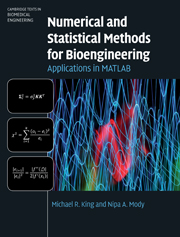Book contents
- Frontmatter
- Contents
- Preface
- 1 Types and sources of numerical error
- 2 Systems of linear equations
- 3 Probability and statistics
- 4 Hypothesis testing
- 5 Root-finding techniques for nonlinear equations
- 6 Numerical quadrature
- 7 Numerical integration of ordinary differential equations
- 8 Nonlinear model regression and optimization
- 9 Basic algorithms of bioinformatics
- Appendix A Introduction to MATLAB
- Appendix B Location of nodes for Gauss–Legendre quadrature
- Index for MATLAB commands
- Index
Appendix A - Introduction to MATLAB
Published online by Cambridge University Press: 05 June 2012
- Frontmatter
- Contents
- Preface
- 1 Types and sources of numerical error
- 2 Systems of linear equations
- 3 Probability and statistics
- 4 Hypothesis testing
- 5 Root-finding techniques for nonlinear equations
- 6 Numerical quadrature
- 7 Numerical integration of ordinary differential equations
- 8 Nonlinear model regression and optimization
- 9 Basic algorithms of bioinformatics
- Appendix A Introduction to MATLAB
- Appendix B Location of nodes for Gauss–Legendre quadrature
- Index for MATLAB commands
- Index
Summary
MATLAB is a technical computing software that consists of programming commands, functions, an editor/debugger, and plotting tools for performing math, modeling, and data analysis. Toolboxes that provide access to a specialized set of MATLAB functions are available as add-on applications to the MATLAB software. A Toolbox addresses a particular field of applied science or engineering, such as optimization, statistics, signal processing, neural networks, image processing, simulation, bioinformatics, parallel computing, partial differential equations, and several others.
The MATLAB environment includes customizable desktop tools for managing files and programming variables. You can minimize, rearrange, and resize the windows that appear on the MATLAB desktop. The Command Window is where you can enter commands sequentially at the MATLAB prompt “≫.” After each command is entered, MATLAB processes the instructions and displays the results immediately following the executed statement. A semicolon placed at the end of the command will suppress MATLAB-generated text output (but not graphical output).
The Command History window is a desktop tool that lists previously run commands. If you double click on any of these statements, it will be displayed in the Command Window and executed. The Current Directory browser is another desktop tool that allows you to view directories, open MATLAB files, and perform basic file operations. The Workspace browser displays the name, data type, and size of all variables that are defined in the base workspace.
- Type
- Chapter
- Information
- Numerical and Statistical Methods for BioengineeringApplications in MATLAB, pp. 560 - 575Publisher: Cambridge University PressPrint publication year: 2010



